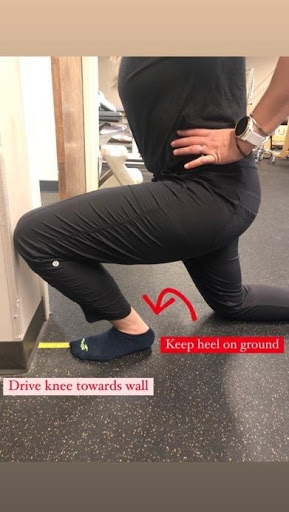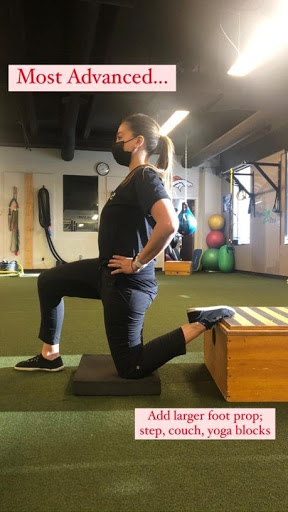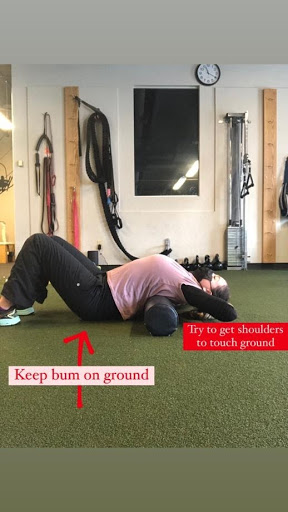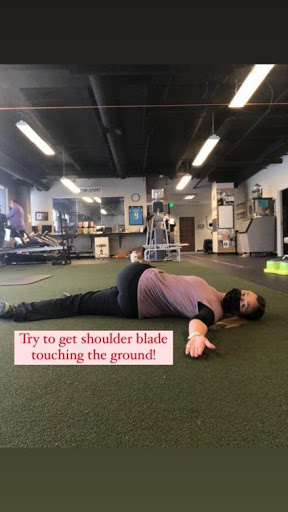by Candace Cox, DPT, ATC, FDN-C
As the weather gets nicer, the eagerness to get outside only continues to grow! As physical therapists and movement experts, the trends every spring always remain the same. We see lots of people getting outside, busting out the new running shoes and adding mileage to their routine! This excites us, but the problem here is that we also see the number of injuries increase. Don’t become a part of the statistics – follow the exercises below to optimize your mobility routine for spring running!
Ankle Mobility
Proper ankle mobility is critical throughout all phases of the gait cycle. Without adequate ankle range of motion, our shock absorption and propulsion suffer, thus affecting our mechanics, speed and oftentimes leads to overuse injuries. Think about it – if the ankle joint is excessively stiff, tight and restricted, extra force goes through surrounding areas. Ankle stiffness can be due to soft tissue (muscle) tightness and/or joint stiffness. These first 3 exercises will target both.
Knee Drives (20 reps)
Start with toes about 4 inches away from wall. Keeping your heel down, drive knee forward in effort to touch the wall. If your heel comes off the ground, move your toes closer to the wall.
Pro Tip: Compare distance toes are from wall on right side vs left side.


Straight Leg Calf Stretch (1-2 min hold)
In a staggered stance, create incline for back foot by placing it on a slant board, dumbbell, yoga block, etc. Keep the back leg straight while the heel stays in contact with the ground.
Pro tip: For increased stretch, lean trunk forward.


Talocrural Self Mobilization (20 reps)
Anchor a thick elastic band to a strong object. Wrap the elastic band around your foot, below your two ankle bones. Increase your distance from the anchor to feel slight traction on the ankle joint. Use yoga strap around your toes to pull your foot/toes towards you. This allows the joint to have slight traction as you maximize dorsiflexion & plantarflexion.
Pro Tip: Place yoga strap around toes before scooting backwards. This makes it easier!


Hip Flexor Length
Got tight hip flexors? Honestly, you probably do. As a clinician, this is the most common deficit that I see almost ALL runners having! Why? Because we sit all day. When we sit, our hip flexors become excessively shorted over time. This causes a cascade of negative effects, some of which being an anterior pelvic tilt, also known as an increased arch in our lower back when running. The repercussions of tight hip flexors greatly affect our running economy. With tight hip flexors, we lose our ability to properly extend our hips and adequately generate power and propulsion. Below you will find the most important exercise, arguably of all time, along with progression as you increase your hip flexor length!
Hip Flexor Stretch
Wrong vs. Right: In the picture on the left, you will see excessive low back arching as well as excessive anterior pelvic tilt, noted by the red Belt Line. In the picture on the right, you will notice the correct position – upright with a posterior pelvic tilt, maintaining hips level.


Proper Hip Flexor Stretch (1-2 min hold)
Place one knee on foam pad, yoga mat, pillow etc. and maintain upright posture. In this posture, think about rotating your hips backwards, in essence consider tucking your tail if you had one. Or perhaps an easier cue is bring your belt to your belly button. Regardless, do not excessively lean forward, arch the back or dump the hips forward.
Pro Tip: Longer stretch time (1-2 minutes) means we must stretch with a lighter intensity. Think about <5/10 stretch intensity since you are holding the stretch longer than 30 seconds.



Mid Back Mobility
All too often, upper body mobility is overlooked when it comes to running. Everyone tends to focus on the lower half of the body, not realizing that there is much to be gained from upper body mobility, specifically the mid-back. If runners have a stiff mid-back, funky arm mechanics are often a result. Runners will excessively swing their arms which causes decreased efficiency, in other words, a waste of energy. Another reason why mid-back mobility is so important is because of our ribs! Our ribs attach to our thoracic spine, also known as our mid-back. If our mid-back moves better, our ribs can expand more. If our ribs can expand more, our lungs can expand more which means INCREASED VO2 MAX!!!
Foam Roller Extension (5 reps)
Place foam roller at mid-back, support your neck and reach backward, aiming to have your shoulders touch the ground. Be sure to keep your butt on the ground.
Pro Tip: After 5 reps, move the foam roller up about 3 inches towards your head. Now repeat the same exercise just with the foam roller in a new position!


Open Books (10 reps each side)
Start laying on your side with both hands extended in front of you together. Place your bottom leg straight and have your top leg bent at about a 90 degree angle. Leave your bottom hand on the floor and open your top hand all the way to the other side of your body. Then close the book, returning to start position, and repeat.
Pro Tip: Keep your eyes on your top hand as you open the book. This is because as your mid-back rotates, your neck should rotate as well. Now we are facilitating this coupled motion!



If you have questions or are experiencing pain or difficulty while running or completing any of these exercises, please reach out for a consultation with a physical therapist!




